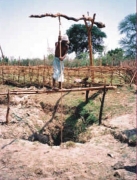 This document by ACWADAM is a report of a rapid geohydrological assessment of some of the microwatersheds from parts of Bolangir district Orissa.
This document by ACWADAM is a report of a rapid geohydrological assessment of some of the microwatersheds from parts of Bolangir district Orissa.
Bolangir district in Orissa forms a part of one of the hottest and backward regions of India with low land-productivity, and opportunities and technologies for agriculture in the district remain relatively unexplored.
Vagaries of rainfall and the underlying hard-rock geology further compound the problem and limit agricultural productivity to a great extent. Given such natural uncertainties, systematic implementation of a watershed management programme is the most viable avenue to overcome the problems of this region.
Bolangir district was thus selected as pilot area to conduct a pre-feasibility exercise for planning of water resources management. ACWADAM, Pune was invited, along with Samaj Pragati Sahayog, Bagli to conduct this pre-feasibility exercise. ACWADAM’s scope of work in the above watersheds included:
- Geohydrological mapping to understand the overall conditions of groundwater resources in the area.
- Describing the framework in which groundwater occurs within each of the watersheds.
- Suggesting a strategy for planning the water management programme in the watersheds, with a focus on groundwater resources management.
The project area included Kalahandi, Bolangir and Koraput districts of Orissa. The investigations were conducted in 12 microwatersheds in different parts of Bolangir district, together constituting an area of 6000 to 7000 ha. The study was undertaken in three steps and included:
- Study of general literature pertaining to the area/region
- Field studies
- Compilation and data analyses
Field studies included:
- Geological and hydrogeological mapping
- Terrian and Land information
- Integration of information into a report
The study found that there were a significant number of structures such as percolation tanks, check dams and small ponds in all the project areas. Reviving these older structures could have a significant impact on improving water resources rather than planning and executing new structures, as this would save time and costs on new structures. Thus, it would be useful to:
- Repair old structures, especially earthen structures
- Desilt structures
- Repair of exits/spillways
It was necessary to evolve a continuous monitoring system that could gauge impacts of interventions (both positive and negative) on the water resources base within any project watershed
It was necessary to focus on better or improved groundwater resources development and groundwater management